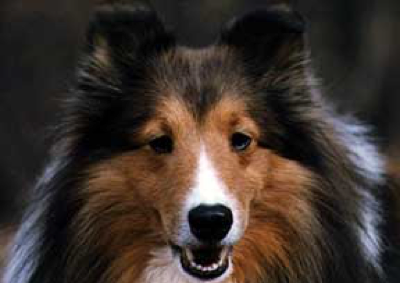
The correct Sheltie ear is beautiful. It contributes to a soft intelligent expression and gives an alert look to the entire dog. It is set high, opening forward, semi-erect :the top third of the leather breaks fonvard with no inclination to turn to the sides. The ear itself is small in relation to the head; the leather strong, yet flexible, and of medium thickness.The dogs look their best when ears have a correct set, they naturally enhance the character, temperament of these special little " Toonies”! Unfortunately, ears can be difficult at times ,even with the best of pedigrees and breeding. They are influenced not only by heredity, but also by emotional stress, teething, puberty, coat loss, temperature, hormone changes, calcium assimilation, humidity, and age. At these times the ears can go'prick"- standing straight up and giving the dog a ‘fox-like’ appearance, or, be 'hound' with one or both ears seemingly trying to fall off the side of the head. There are some ears that will be perfect regardless of the environment and having never been touched; others will appear utterly hopeless with little chance of looking like show dogs -despite all your efforts. Take heart, the majority of ears can be helped at those crucial times-especially during teething from about 10 weeks of age to nine months; with a little diligence and patience your dog has an excellent chance of growing up with 'beautiful ears'.
DON’T WAIT--THE SOONER YOU BEGIN--THE BETTER CHANCE YOU HAVE !
There are a number of methods that have been used over the years, some more succesful than others. Talk to a few 'old timers' and they will tell you all about their trials, and having used everything from weights (poultice, pine tar, hooflex) to softeners (Cuticura Ointment, glycerine, neatsfoot oil, Bag Balm, etc.). Most of these will produce disappointing results; however, there are basically two ways that we use ourselves that have proven to be consistent, and for that reason, are the ones we recommend. The easiest, and to some, the best overall process, is the use of "Speed Sew ", “Val-A Tear Mender”, or "Jiffy Sew"- most top breeders today utilize this technique-the hardest problem for most people to overcome in using this method is in securing the products! If you're fortunate enough to be able to get a tube or two of one of these glues the enclosed reprint of an article from the SHELTIE PACSETTER should lead you through this rather straightfonvard process with little trouble. The additional technique is the use of "Japanese Surgical Tape" and/or "moleskin", duct tape and engine starting fluid- though a little bit more time consuming in the application process and in replacement frequency it has been equally successful in correcting wayward ears, and, supplies needed are usually more easily found locally: you will find a "how-to" sheet for this in the "Your New Sheltie" sold on the Sheltie Primer page!.
Beautiful Ears
Originally Posted 2009/Updated January 2021